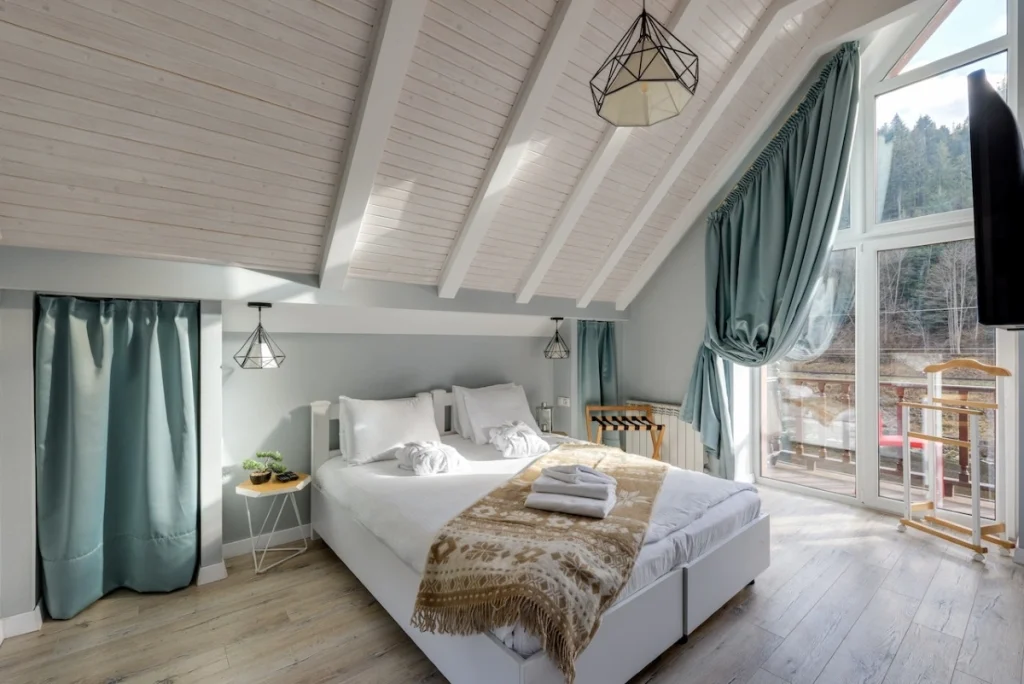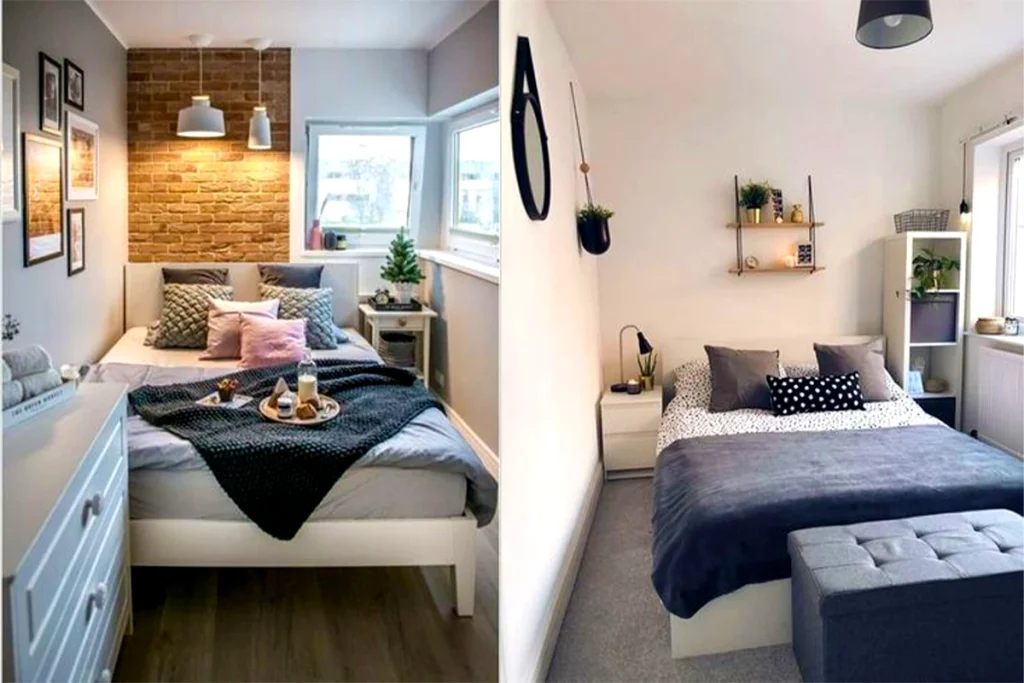Some people think that they have insomnia, but the reason may come from their bedroom. This article will help to improve sleep through bedroom colors and other factors such as bedding, mattress, air, smell, and curtain…
Best bedroom colors for sleep
The relevance between color and psychology was demonstrated by researchers, so the color was applied to improve sleep quality. There are some colors such as blue, peach color, and pink… can help the brain calm down for a night of deep sleep.
A cozy peach color bedroom for sleep
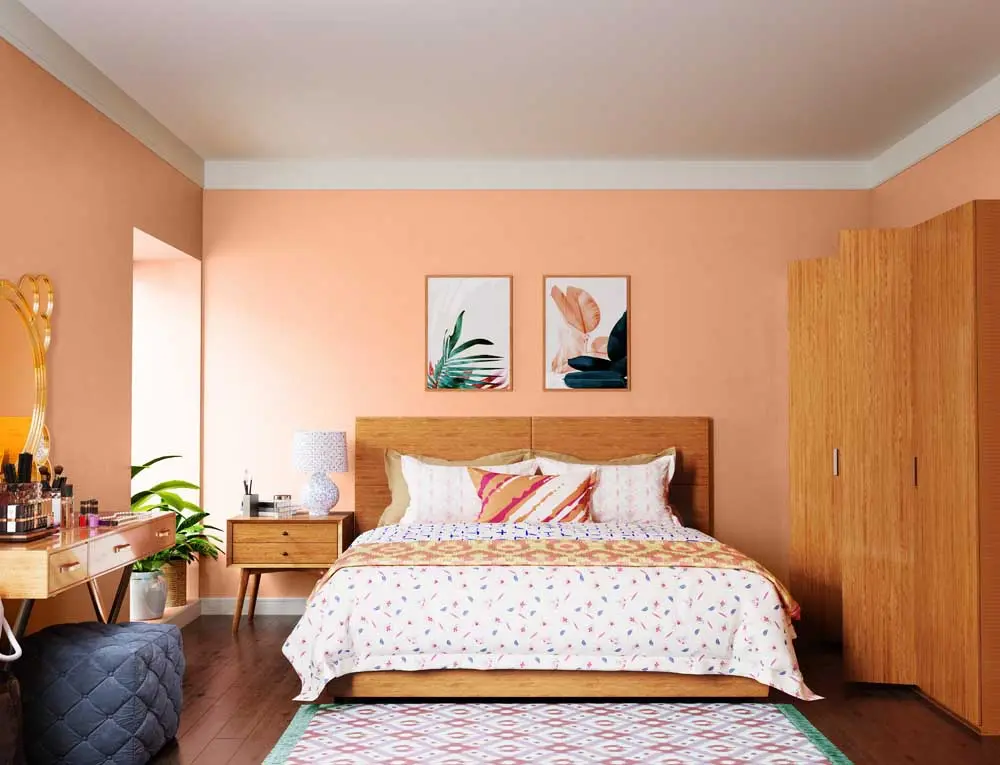
Peach color represents communication, friendship, and happiness. It also has a positive influence on our emotions.
Peach color evokes feelings of comfort, joy, and warmth. Peach color will provide a serene impact on our mind, so it will protect us from negative emotions such as sadness and disappointment.
With those features of peach color, it can improve sleep as well. In winter, especially, when the weather becomes cold and the atmosphere is dreary, which evokes lonely and sad feelings. Stepping into a cozy bedroom with peach color will make sleep more comfortable.
Blue paint colors for the bedroom to have a restful sleep

When looking at the blue color, people usually think about the ocean or sky. So, blue is a symbol of freedom, imagination, and open spaces. It also represents trust, royalty, serenity, and peace.
For psychological impact, the blue color will create feelings of calmness, relaxation, confidence, and reliability. The association of blue with serenity and calm was demonstrated in a research named “Interior Color and Psychological Functioning in a University Residence Hall” in 2018. According to the study, I think blue is the best color for the bedroom to have a deep sleep.
On the other hand, dark blue can also evoke feelings of sadness and depression. Therefore, I prefer using light blue rather than dark blue for the bedroom to have the best effect.
White and grey bedroom colors for sleep
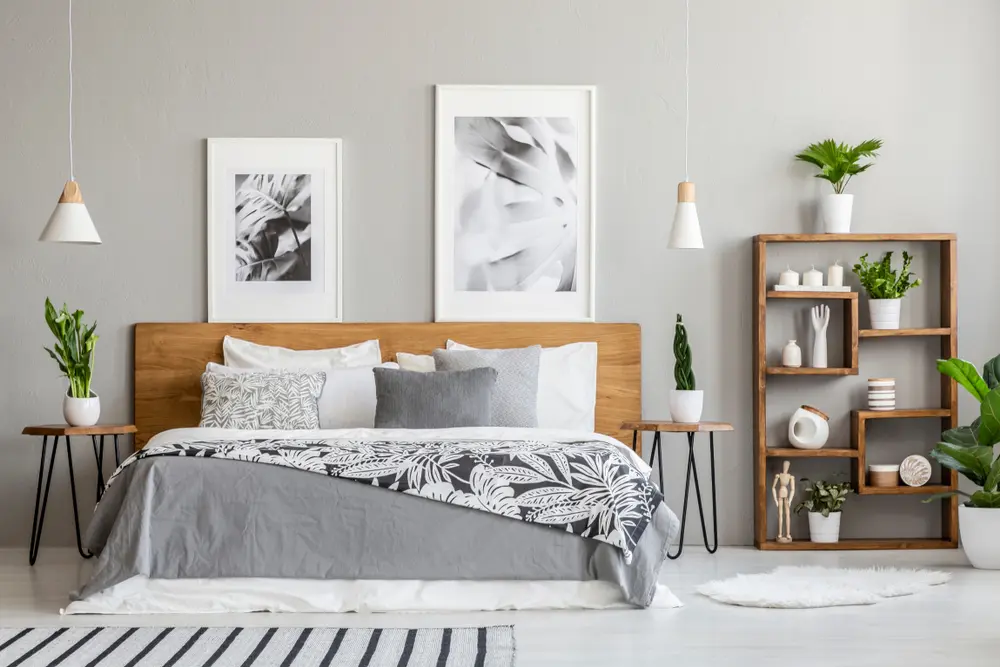
Another choice for your bedroom color is a combination of white and grey color. White is associated with purity, freshness, and innocence, while grey is known as a color of balance, neutrality, and stability.
White can re-freshen our minds, but there is a disadvantage that has a bad impact on sleep. A bedroom dominated by white looks more bright than others because white reflects all the visible wavelengths of light that shine on it. To reduce the impact of the light reflection of white color on our sleep, let’s combine white with other colors such as grey. Grey affects the brain with some supportive emotions for sleep such as calmness, relaxation, and soothing. However, like dark blue, dark grey can raise a gloomy atmosphere, so using light grey (silver color) for the bedroom to have a good sleep. In this combination, using silver color for the bedding set is preferred to white color, because a white color bedding set will easily show dirt on them and get old quickly. Image credit: PaintGreen
Positive impacts of pink bedroom colors on sleep

Pink, a favorite color of most girls, presents femininity, love, and playfulness. It has some good effects on the emotional state that can help us sleep well. Pink may evoke feelings of calmness, peace, relaxation, and satisfaction. In the late 1960s, a researcher, Alexander Schauss, studied psychological and physiological responses to the color pink. He convinced the directors of a Naval correctional institute in Seattle, Washington to paint some prison confinement cells pink, Baker-Miller Pink, to see the effect of pink on prisoners. As the result, pink was demonstrated to reduce aggression and lower blood pressure.
However, hot pink can bring the effect as same as red, that are increasing energy, blood pressure, and pulse, and causing palpitations. Therefore, in order to have a nice sleep, soft pink is recommended for the bedroom color.
Worst bedroom colors for sleep
Besides the best colors for sleep, there are also some colors having bad effects on sleep.
Red bedroom

Red usually symbolizes excitement, danger, energy, or action. So, it has some negative impacts on the emotional state, which make us hard to fall asleep. Red stimulates energy, evokes aggression or anger, and increases blood pressure and heart rate. Red also creates the feeling of caution, which is the reason why red is used in signals and alerts of caution. With those negative traits, the red color is absolutely a bad idea for the bedroom.
Purple paint for bedroom

Purple is another bad color for the bedroom. It is associated with a variety of meaning such as creativity, luxury, power, and magic… Purple stimulates creativity and imagination, which means the brain is still working, so it is not easy to wind down for sleep. Keeping purple out of the bedroom is a smart choice.
Black bedroom
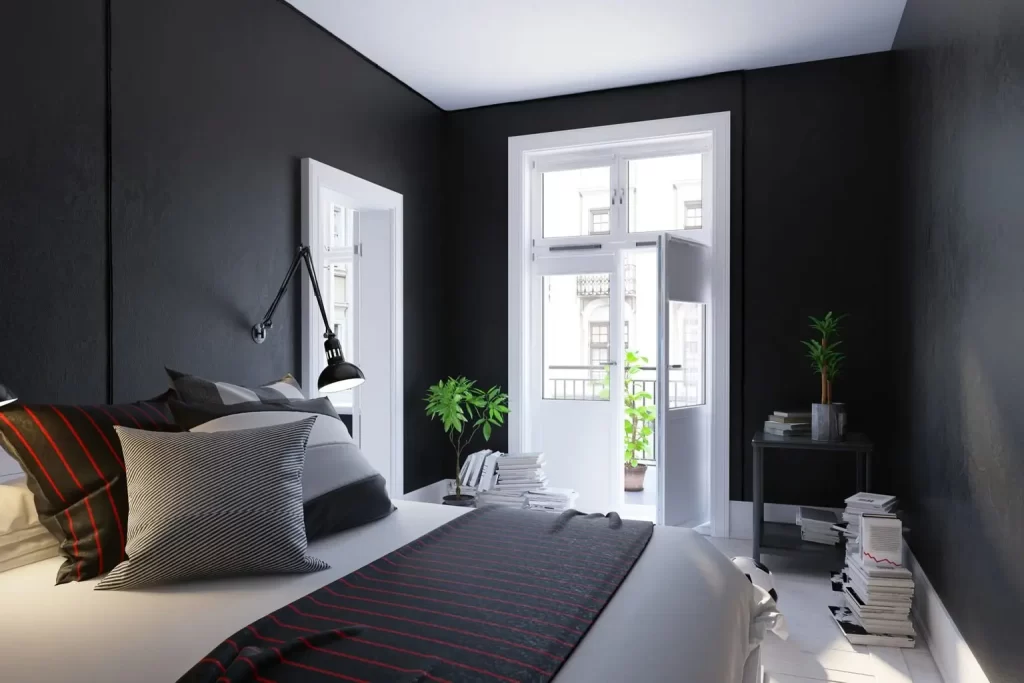
When mentioning black, many people will think that black is so dark, so it’s a suitable color for the bedroom. However, the effect of black is the opposite. Black presents power, elegance, and strength, but it is also known as a symbol of total sadness and depression, fear, evil, and death. Sleeping in a bedroom dominated by black will evoke feelings of sadness, loneliness, and fear, especially for kids, and the probability of having a dark nightmare is higher than in other colors. Therefore, black is not recommended for the bedroom.
Other factors combine with bedroom colors for a nice sleep.
Along with bedroom colors, other factors such as bed size, bedding, mattress, air, and light… are also considered for deep sleep.
Bed size
To sleep like a baby, the first thing we have to do is choose the right bed size. The bed selection is based on aspects such as the bedroom size; whether the bed is the focal point; the number, height, and weight of people lying on that bed. In this article, the bed selection is only based on the aspect of the normal adult number. A twin bed is enough for one person, but I recommend a full double or queen bed for people who live alone. Because it will be more comfortable in case a friend visits and stays overnight. For a couple, the ideal size is a queen bed. And for a family with 1 child, a king bed is a perfect choice.
Bedding and mattress
Bedding and mattress play an important role in our sleep. Determining the sleep position is the first step in selecting the right bedding and mattress. The mattress is commonly divided into 6 firmness levels including Extra-Soft, Soft, Medium, Medium-Firm, Firm, and Extra firm.
For side sleepers, a combination of a Soft/ Medium mattress with a thick/firm pillow is a suitable choice, because it will help to support the neck and keep the spine aligned.
For back sleepers, the best mattress firmness levels for these people are Medium and Medium-Firm. A medium-thick pillow is usually the favorite of a back sleeper. If a back sleeper uses a set of a soft mattress and thick pillows, like side sleepers, his head will be pushed too far forward and hurt the neck.
For stomach sleepers, they will look for a Medium-Firm/Firm mattress and soft/fairly flat pillows to help their neck stay in line with the spine.
For those who have a variety of sleep positions, a medium mattress and medium-thick pillows are the common choices.
Duvet, comforter, or blanket is the factor that we also need to focus on. I recommend using the duvet instead of a comforter or blanket for two reasons. First, the duvet cover, which a comforter or blanket does not have, can be changed and washed easily. The owner can change the color of the duvet at a cheap price. He can also switch to a cooling duvet cover when the summer comes. Second, a duvet tends to be heavier than a comforter or normal blanket, so it will have the function of insomnia treatment as a weighted blanket. This function was demonstrated by a study conducted by researchers at the Karolinska Institute in Stockholm, Sweden.
Night light
In 2017, researchers conduct a study to find out which color light is the best for sleep. As the result, The researchers determined that the preferred color light will make people fall asleep quicker than dark, white light, and non-preferred color light. Therefore, a combination of bedroom colors and a preferred color night lamp is the best for sleep. I recommend using a night lamp that can adjust the brightness to achieve the best effect.
Air and smell
Air quality plays an important role in sleep, research has found that ventilation or fresher air is associated with better sleep. So, adding some plants such as Jade plants, Aloe Vera, or Lavender…. to the bedroom will improve air quality. They will produce oxygen at night and purify the air.
A bad smell is really bad for sleep, so let’s keep it stay away from the bedroom. Instead of that, A scented candle can help to improve the quality of sleep. I suggest the lavender-scented candle because Lavender was demonstrated that has good impacts on sleep.
Curtain
The curtain will help to block light from sunlight, streetlight, or lightning to support a restful sleep. Blackout curtains are an ideal choice for the bedroom. They will completely prevent the lights and noises from outside.
Bedside table (nightstand)
The bedside table is absolutely a must. That table will help store the stuff that supports sleep. It may be a phone for those who have the behavior of using the phone before sleep, a book for the book lover, a scented candle, a plant, or a bedside lamp…
Carpet
Setting up some carpets around the bed is very supportive for sleep. It will help reduce the noise if someone is walking around the bed. It also provides a comfortable sense for the feet when waking up for going to the toilet at night, the feet will be not shocked by the cold floor.
Conclusion
In conclusion, some colors can be applied to the bedroom to enhance sleep quality such as blue, peach color, white and grey (silver grey), and pink… Besides, some colors that harm sleep should be avoided such as red, purple, and black… Furthermore, sleep can also be better by other factors such as bed size, bedding, mattress, night light, air, smell, and bedroom furniture setup.
